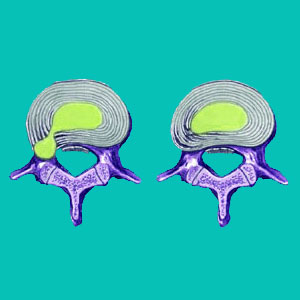
The annulus fibrosus is the thick, protective outer wall of the intervertebral disc structure. This protective wall surrounds the nucleus pulposus on every side and also attaches the disc to the vertebral bones through cartilaginous end plates. The outer disc wall is rarely overly affected by degenerative disc disease, but is the structure which fails in the case of a herniated disc.
This explanatory article will provide everything you need to know about the anatomy of the outer spinal disc wall. We will look at the construction of the disc and how various degenerative and injurious processes affect the annulus.
Annulus Fibrosus Structure
The disc wall is made up of fibrocartilage and collagen woven together in layers, like a basket. These intertwined layers created a very strong design capable of handling the immense forces placed on the spinal discs during vertebral movement and loading.
The disc wall is very flexible and can mold its shape to suit the current position of the spinal column. This outer disc wall is composed of many layers of cells, arranged in rings like the inside of a tree, hence the name annulus.
Outer Disc Wall Failure
When the outer disc wall is stressed beyond its tensile strength, it might bulge or tear. A disc bulge will fill with nucleus material, creating a herniated disc. This bulge might be small and insignificant or may be large and problematic. However, statistics show that most disc herniations will not cause long-term severe pain, if any at all.
If the outer wall of the disc tears, a ruptured disc will be created. This is when some or all of the nucleus spills out of the opening in the disc wall and into the body cavity.
Some doctors believe this disc material to be irritating to the nerves and other spinal structures, while other doctors do not think it causes any real cause for concern. The diagnosis of nerve root irritation caused by nucleus proteins is called chemical radiculitis.
Annulus Fibrosus Conclusions
Although the outer disc wall is very strong, it is rare that a person will not suffer some break down of these structures, especially in the lumbar and cervical spinal areas. This explains the high incidence of herniated discs in these highly mobile spinal regions.
Disc problems are much less common in the thoracic spine, since this region does not endure the same stresses as the upper and lower ends of the spinal column.
Keep in mind that it is possible to be diagnosed with an annular tear and still suffer no pain. In fact, many compromised disc walls might be damaged, but still maintain enough structural integrity to contain the nucleus for many years. Learning the truths about herniated discs is the most important first step in curing a painful condition which is either due to, or simply being blamed upon, a disc herniation occurrence.




